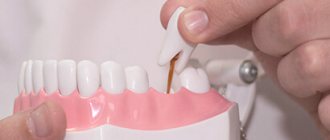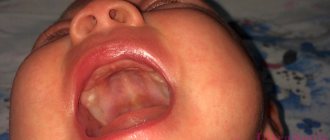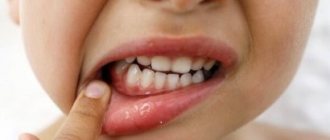Features of the oral cavity
The mucous membrane of a healthy child's mouth is bright pink due to the large number of blood vessels. As she grows older, her shade fades.
The epithelial layer is distinguished by tenderness and vulnerability, as well as some dryness due to the not very active work of the salivary glands (up to 3-4 months).
The baby's mouth is ideally suited for sucking. A wide tongue, a fold on the gums formed by the mucous membrane, pads on the inside of the lips, a “suction cup” on the upper lip - all this provides a tight grip on the bottle or nipple and facilitates the process of obtaining food.
What features or problems can be detected by looking into a baby’s mouth? Main options:
- white bumps on the palate;
- abnormal appearance or position of the tongue;
- white plaque on the inside of the mouth.
"Epstein's Pearls"
In 65-85% of babies after birth, several yellow-white tubercles with a diameter of 1-3 mm are found along the palatine suture. They are called palatal cysts or “Epstein's pearls.”
They are formed from residual fragments of the epithelial lining, which is destroyed under the influence of enzymes during fetal development. Epstein Pearls are filled with keratin.
Palatal cysts do not require treatment and do not cause discomfort to the child. They atrophy on their own in the first months of life.
Is research necessary?
Usually, thrush in the mouth of a baby does not require additional research, since it is not difficult for an experienced specialist to diagnose it based on obvious signs. But sometimes, in case of serious lesions, additional studies may be prescribed:
- microscopic: in this case, the doctor will take scrapings from the oral mucosa to examine the yeast-like fungal cells more carefully;
- bacteriological: during such a study, a scraping is also taken and then bacteria are cultured to understand how large the volume of fungal colonies is and how amenable to treatment they are with antifungal drugs; in addition, bacteriological testing helps determine which drug is the most effective in treatment, because some of them may not have an effect in the treatment of thrush;
- serological: this study requires a blood test, in the serum of which antibodies to fungal infection are examined.
Language
Normally, the tongue is located along the midline of the jaw. If there is a constant deviation (recession) to the right or left, parents should show the child to a neurologist. This symptom may indicate damage to the caudal group of nerves of the skull. An additional sign is a drooping soft palate.
Another reason to seek help is that the language is too broad. This symptom is observed with hypothyroidism (decreased functional activity of the thyroid gland) and some genetic syndromes.
The listed phenomena are rare, unlike a short hyoid frenulum. This minimal anomaly in the structure of the maxillofacial apparatus can be determined visually; in addition, when screaming, the tip of the baby’s tongue rises. A short frenulum is not dangerous, but it can make sucking difficult and, in the future, complicate the pronunciation of sounds. In infancy, it is easily cut with a scalpel in an outpatient setting without suturing and virtually no blood.
White plaque
The tongue and palate of an infant may be covered with a thin whitish coating. Main reasons:
- leftover food;
- mouth breathing;
- thrush.
Leftover food
Immediately after feeding, you can see the remains of breast milk or formula on the baby's tongue and palate. After some time, the plaque disappears on its own. Many pediatricians advise removing traces of food from the baby’s mouth, as they serve as a breeding ground for opportunistic microorganisms.
Cleaning methods:
- give the baby 1-2 teaspoons of boiled water immediately after feeding;
- wipe the epithelial membrane 2 times a day with soda solution or water (the procedure is described below).
If the plaque is easily removed or disappears on its own (it is not present before feeding), do not worry. But in cases where white marks on the tongue, palate and inner surface of the cheeks are constantly present, it is necessary to consult a doctor.
Mouth breathing
If a child breathes through his mouth, his mucous membrane dries out and a whitish coating forms on it. In children under one year of age, this phenomenon is most often caused by acute respiratory viral infections and dry air in the room, which leads to the formation of crusts in the nasal passages.
The only way to prevent the formation of white plaque is to restore nasal breathing in the baby. Basic methods:
- when the mucus dries out, instill saline and oil drops into the nose, as well as humidify the air;
- for a runny nose and congestion due to ARVI - similar measures, in addition, the doctor may recommend the use of vasoconstrictor drops (no longer than 5-7 days).
Why is a sore throat dangerous?
As practice shows, only in half of the cases are enlarged tonsils and sore throat caused by purulent sore throat. Many diseases, such as diphtheria or Epstein-Barr virus, have symptoms similar to sore throat. Therefore, only a qualified doctor with modern diagnostic equipment and a well-equipped laboratory can accurately determine the disease and prescribe the necessary treatment.
Each causative agent of sore throat is sensitive to a certain type of antibiotics prescribed by a doctor depending on the diagnosis.
Remember!
Incorrect or untimely treatment of sore throat in children, as well as relying on folk remedies for “red throat” can lead to serious complications and irreversible consequences.
Delay in diagnosis and prolonged treatment provoke the development of rheumatoid arthritis, vascular diseases, heart diseases (including rheumatic endocarditis), renal failure and many chronic diseases leading to disability.
The essence and causes of thrush
Microscopic yeast-like fungi of the genus Candida live on the mucous membranes and skin of every person. They do not cause harm to health, but only if the immune system suppresses their active reproduction. Otherwise, an inflammatory disease called candidiasis occurs. If fungi colonize the oral mucosa, candidal stomatitis, or thrush, is diagnosed.
The disease is detected in 4-5% of infants. Its main reasons:
- low level of immunity, characteristic of all newborns;
- decrease in protective forces as a result of teething, acute respiratory infections, dysbiosis, intestinal infection, and so on;
- non-compliance with hygiene standards - insufficient cleaning of children's dishes, toys, mother's skin (during breastfeeding);
- antibiotic treatment, which disrupts the balance of bacteria on the mucous membranes;
- drinking sweet tea, water, compote or a mixture - leftover sugar in the mouth contributes to the growth of fungi.
In addition, a baby can “get” too many candida when in contact with adults. Most often, infection occurs during childbirth if the mother has genital thrush. Kissing and sharing utensils can also lead to infection if an adult has candidal stomatitis.
Symptoms of oral candidiasis
The main sign of thrush in an infant is a permanent white coating, reminiscent of cottage cheese or yogurt, on the tongue, palate, gums, inner surface of the cheeks, and lips. At first it looks like small spots (“plaques”), which gradually grow. If you remove them with a bandage, a bright red inflamed mucous membrane is revealed.
As the disease progresses, the white spots become yellow or grayish. Small bleeding erosions form under them. The child experiences discomfort, therefore behaves restlessly and sleeps poorly. When sucking, the unpleasant sensations intensify, as a result, many infants refuse to eat.
In severe cases, fungal microflora leads to the formation of a dense film on the oral mucosa. Over time, it spreads to the throat, tonsils, esophagus and internal organs. The child may have a fever and a significant deterioration in general condition.
Diagnostics
If a baby has a white spot in the mouth, to make an accurate diagnosis, a number of tests are prescribed, as well as certain procedures. Usually the doctor immediately notices the problem when examining the surface of the mucous membrane. In addition, the following may be additionally prescribed:
- Scrapings or smears from the cheesy film;
- Collecting anamnesis during a conversation with parents;
- Clinical blood test;
Purpose of the study: detection and confirmation of Candida fungi. If necessary, the mother must additionally show the child to specialized doctors. This will help identify the inflammatory processes that occur in the internal organs, which will help prevent serious complications. An oral smear plays an important role in making a correct diagnosis. After drying the applied scraping onto medical glass, staining and examination under a microscope are carried out. Identification of fungal colonies allows the doctor to select the desired therapeutic regimen, taking into account the characteristics of the body and the age of the patient.
Help for thrush
A pediatrician may suspect thrush based on an examination of the oral cavity. To confirm the diagnosis, it is worth taking a swab from the throat and determining the state of the microflora. If the number of Candida fungi exceeds the norm, the child has candidal stomatitis.
Local treatment
In most cases, local treatment of thrush is carried out in infancy. The safest method is to wipe the oral mucosa with baking soda. Stages:
- Prepare a weak solution of soda - 1 small spoon per 1 glass of boiled warm water.
- Wrap a sterile bandage around your clean index finger.
- Soak the bandage in a soda solution.
- Wipe the baby's mouth. There is no need to try to remove the plaque, just carefully treat it from above.
The procedure should be repeated every 2-3 hours for several days. If the child does not open his mouth, you should press your finger on the chin and hold it.
Another method of treatment is wiping the mouth according to the scheme described above with a solution of honey and warm water (in a ratio of 1:2). Honey has antimicrobial and anti-inflammatory effects. But you should remember that it is a very strong allergen.
If traditional methods do not help get rid of stomatitis, the doctor may prescribe external antifungal agents. Here are some of them:
- acidophilus powder;
- Candide solution;
- nystatin ointment;
- Shostakovsky balm;
- gentian violet solution and so on.
The method of their use is indicated in the instructions. Usually it is necessary to apply an ointment or solution to the mucous membrane several times a day. The duration and dosage are determined by the doctor.
Systemic drugs
In case of advanced candidiasis, systemic antimycotics are prescribed in parallel with local remedies in a dosage that is safe for a small child. The main drugs are Diflucan, Mycomax, Nystatin, Amphotericin B, Ketoconazole. They should be given to the baby for 5-10 days. It is important to follow the treatment period determined by the doctor, even if the symptoms of candidiasis have disappeared.
If your baby suffers from pain, you can give him ibuprofen in an age-appropriate dosage or paracetamol. In addition, it is advisable to use local analgesic gels, which are used during teething.
Along with the destruction of fungal flora, it is important to pay attention to increasing the child’s immunity. According to the doctor's decision, it is worth giving him B vitamins. If dysbiosis is present, it must be treated. It is recommended that a nursing mother undergo antifungal therapy with her baby, even if she has no symptoms.
Prevention
The risk of developing candidal stomatitis is especially high in the first 6 months of a baby’s life, since his immune system is just developing. To prevent disease, it is important to follow the following rules:
- rinse your breasts with clean water before feeding;
- offer the baby some water after a meal or burping;
- strictly observe the rules of hygiene for all adults in contact with the child;
- Regularly sterilize bottles and pacifiers.
After an illness, to prevent re-infection, it is worth boiling all toys and children's dishes. If the item cannot be treated with hot water, it is recommended to rinse it with a soda solution.
The main reason for a white palate in a baby is the accumulation of food debris in the mouth after feeding. Traces of formula or milk disappear on their own and are not visible before the next meal. Persistent plaque in most cases is a sign of candidal stomatitis (thrush). This disease is treated with local and/or systemic agents with an antiseptic effect. At the initial stage, thrush is not dangerous, but as it progresses it can lead to the formation of ulcers on the mucous membrane and the spread of infection.
Therapy methods
Treatment of candidiasis begins with treatment of the oral cavity. The first procedure is performed by a specialist at the appointment. Antiseptic agents are used to remove plaque. The doctor may then apply an antifungal agent.
The parent should closely monitor the dentist’s actions, since in the future they will have to treat the oral cavity themselves at home. The necessary medications will be prescribed by a specialist. Local antifungal agents are dangerous in case of overdose, especially for children, so you must strictly follow your doctor’s recommendations.
In advanced cases, medications are prescribed in the form of solutions, drops or tablets. There are few drugs available to treat candidiasis in children. Replacing them with adult counterparts is also dangerous. The dosage must be strictly observed.
A mandatory addition to the main therapy is maintaining good hygiene, good sleep, proper nutrition and taking measures to strengthen the immune system (eating healthy foods, taking pharmaceutical vitamins if necessary, walking, etc.).









